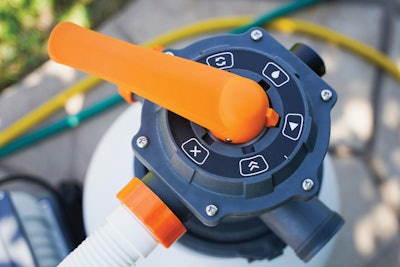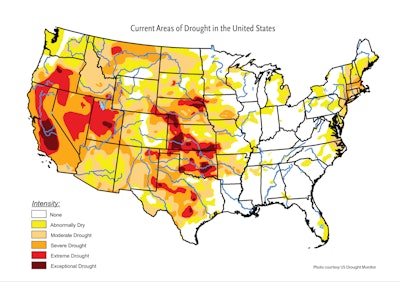
The southwest has been dealing with some degree of drought for decades, but the current water shortage is cause for more concern than usual. The last few years have been dry even by the standards of a dry region, and the response from state and local government has been more draconian, some of which has affected the pool industry.
In areas of Southern California, pool permits are being delayed or denied to builders, and recently, Las Vegas ruled to limit pool construction to 600 square feet or less. The main concern for our industry is that if rains and snowmelt don’t return, and aquifers don’t start to refill, these kinds of restrictions will not be confined to outliers, such as Las Vegas, but will become the norm. That is, the situation could get worse; on the other hand, efforts made now can mitigate that possibility.
In drought-stricken areas, the pool industry’s existential battle plays out on two fronts. There is the real, demonstrable level of water usage for pools and spas, and then there’s public perception.
Both are important.
The perception battle is being waged using the tools of persuasion (see sidebar, “The Battle for Public Opinion,” below), and not only impacts what local councils and state legislatures might do, but also what individual homeowners might think as they contemplate the purchase of a pool.
Meanwhile, the battle to reduce actual consumption is advancing along a number of lines. Water-saving products and methodologies are improving and having an impact, from covers that dramatically reduce evaporation to forward-looking approaches to pool chemistry that obviate water dumping to the subject of our story today, filtration.
The way we filter pool water definitely impacts usage, and that fact should be considered along with other factors such as purchase cost, resulting clarity (particle size capture capability), and maintenance effort/ costs.

Washed Away
Many people, even within the industry, are surprised to learn the filter can play a role in water conservation. After all, it’s sealed in a tank, and plumbed into the circulation system. But it has to be cleaned frequently, and that entails water loss, regardless of filter type.
The disparity in cleaning water usage is caused by the need to backwash D.E. and sand filters, as opposed to cartridge filters that are not backwashed, but merely spray-cleaned with a hose.
To backwash either a D.E. or sand filter, the service technician turns off the pump (important), flips open the backwash valve, and then turns the pump on again. Dirty water gushes out. The service tech watches through a little sight glass in the waste port as the rushing wastewater turns from cloudy-gray or green to clear, then shuts it down and closes the valve.
(It’s worth noting in an article on conservation that over time, the backwash valve on a D.E. or sand filter consumes a fair amount of electrical energy by adding another obstruction to flow and thus, raising the circulation system head.)
Spray Down
Cartridge filter cleaning is more straightforward. There’s no valve to open; you just open up the pressure bleeder on top of the unit, take off the band, remove the cartridges and spray them off.
Richard Medina, an engineer whose career in pool filtration spans all three major types of filter media — D.E., sand and cartridge — compares the water loss numbers for both cases.
“When you open up the tank on the cartridge filter, you lose some water in doing that. And then, if you’ve got a four-up unit where you have four cartridges inside of that tank, you’ve got a hose each one down, and a service pro might spend 15 minutes or so cleaning off the cartridges. That’s 15 minutes of garden hose pressure times the cross sectional area of a garden hose outlet you’re using.”
A conventional sprayer attachment is sometimes used, as is an attachment specifically designed for the job like an Aqua Comb or Filter Flosser, which is more efficient in terms of both time and water.
“And really, every gallon of clean water counts,” Medina says. “So maybe you’ve lost 20 gallons from the tank taking the cartridges out, and perhaps another 20 to 40 gallons or so to clean off the cartridges.”
On the other hand, when backwashing a D.E. or sand filter, he says, “You’re running a pump at maybe 30 gallons a minute, trying to clean out your grids, so you do run through quite a bit of water when you backwash. Say you have that pump going for five minutes at 30 gpm, that’s 150 gallons, depending on how much debris is loaded into your tank.”
Based on that scenario, a cartridge filter saves something in the ballpark of 100 gallons per cleaning. Of course, this usage breakdown contains a number of variables and assumptions; it’s meant to be a qualitative analysis.
To get an idea of the total wastewater differential between backwashed filters and cartridge filters, the frequency of cleaning must also be considered, and this varies widely, but with 2 million inground pools in parched California, Nevada, Utah, Arizona and Texas, a shift away from backwashed filtration would have an effect on water usage in those drought-stricken states.
Recommendations
There are other things you can do to help save water, says Medina. “There are products out there that are specifically geared to clean cartridges — soaking solutions as well as these spray-on applications that you can use to aid in breaking down oils, grease, etc., so you’re not spending an inordinate amount of time spraying down the cartridge to clean it. After a good soak, it’s just a quick rinse off, and you’re back in action.”
Some service departments/ companies have this process organized and systemized so that dirty cartridges at individual homes are replaced with clean ones on the spot, while the dirty ones are tossed in the van and brought back to the home base for mass production cleaning. There, they get their soak and spray down in batches to speed the process.
When they dry, they’re ready to be installed wherever needed.
“That makes a lot of sense for a company,” Medina says. “That way, they’re saving water and labor, both of which are in limited supply.”












































